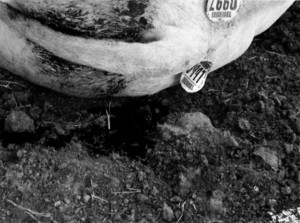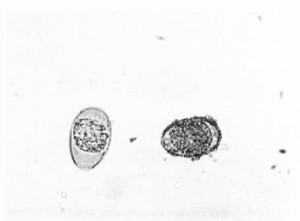Coccidiosis Treatment and Prevention in Cattle
- Jump To:
- What is Coccidiosis
- Prevention
- Conclusions
What is Coccidiosis
Coccidia are protozoan parasites that are host-specific; e.g., cattle have their specific coccidia (Eimeria sp., Figure 1), poultry have their coccidia, etc. The oocyst is shed in the feces of both affected animals showing symptoms and carrier animals not showing symptoms. The oocysts sporulate (undergo maturation) in moist warm environments and become infective. Coccidia oocysts are ingested by animals when they consume contaminated feed, water, pastures or lick a dirty hair coat. If ingested, the parasite can develop inside the host animal, causing damage to intestinal cells and potentially resulting in the host animal having diarrhea and blood in the feces. Damage to the intestinal mucosa also impacts the animal’s ability to absorb fluids to compensate for the water losses in the diarrhea. The oocyst is highly resilient and can survive in moist shaded areas for several years.

Figure 1. Bloody diarrhea in steer with coccidiosis.
The disease: Many animals are exposed and infected with coccidia and do not develop symptoms, but go on to develop species-specific immunity. Disease occurs when large numbers of the infective form of the protozoa (oocysts) are ingested, the cattle are stressed or the animals’ immune response is compromised. Weaning, shipping or moving cattle may cause sufficient stress to cause illness and clinical signs. Sick animals usually have acute diarrhea with or without blood (Figure 2), decreased appetite and mild depression. In more severe infections, this may progress to severe depression, dehydration, pale mucous membranes, straining and severe weight loss. Some cattle with coccidiosis may present with neurologic symptoms. Death may occur despite therapy. The disease commonly affects young animals managed as groups in unsanitary conditions. Calves as young as 16 days of age may be affected. Older cattle are less susceptible to disease than younger cattle unless they are experiencing extreme stress or have depressed immune systems.

Figure 2. Oocysts of Eimeria sp. coccidium of cattle. Oocysts are shown X 400.
The more chronic form of the disease causes reduced growth rates, and/or acts as a stressor, causing increased susceptibility to other infections, such as salmonellosis (intestinal disease), or Bovine Respiratory Disease. Coccidiosis is primarily a disease that affects young animals, but can affect older animals that are in poor condition or are immune compromised. It occurs commonly in confined conditions, but can occur in free-ranging conditions that have congregating areas, such as feeding, shade and watering areas.
Economics: Coccidiosis can cause significant economic losses due to reduced performance, death from direct infections, and by predisposing cattle to secondary bacterial and viral infections. Additional economic losses occur because of the labor demand for care and treatment of infected cattle and medication costs.
Transmission: Coccidiosis is transmitted from animal to animal by the fecal–oral route. Infected fecal material can contaminate feed, water or soil; therefore, cattle can contract the disease by eating and drinking from contaminated sources, or by licking itself or other animals. Calves may become infected by nursing contaminated udders. The severity of clinical disease depends on the number of oocysts ingested. The more oocysts ingested, the more severe the disease.
Diagnosis: Coccidiosis is diagnosed by clinical signs, fecal examination by flotation or smear, and by postmortem examination. Clinical signs usually occur about 17 days after ingestion of oocysts. By the time clinical signs occur, the damage is far advanced, and the coccidia life cycle in the animal is completed. The history frequently includes a preceding stressful event in the animal’s life. It must be noted that coccidia can be found in the feces of normal healthy cattle and diagnosis must rule out other diseases such as BVDV, salmonellosis, internal parasites and toxicities.
Treatment: The most effective treatment for the already sick animal is supportive therapy (fluids) and antibiotics to ward off secondary infections. Ideally, owners should isolate the affected animal(s) to prevent increased contamination of the premises. Amprolium at 10 mg/kg/day for five days and sulfonamides are commonly used as treatments for clinical disease (Table 1). Drugs administered in feed or water may not be consumed by sick animals, and severely affected animals may need to be handled and treated individually.
If there is one clinical case in a group of cattle, it is highly probable that others have been exposed and harbor coccidia in the intermediate stages of development. Due to the drug susceptibility of the parasite in the intermediate stages of development, preventive therapies should be instituted. Drugs useful for treatment are not necessarily useful for preventive therapy and vice versa. Anticoccidial-preventive therapies commonly used in cattle should be used according to label recommendations, paying careful attention to maintaining preventive levels for periods long enough (28 days or longer) to affect the life cycle of coccidia. Anticoccidial preventive therapies may be incorporated into beef cattle rations and supplements.
The most effective coccidiosis program focuses on preventive therapies before clinical signs appear.
Prevention
Prevention focuses on preventing fecal contamination of the cattle’s environment, feed and water. Preventive measures for confined cattle include:
- Clean water tanks regularly, with more regular cleaning when new animals are introduced.
- Clean feces from feed bunks before each feeding.
- Clean and disinfect holding areas between groups of cattle. Drying and exposure to sunlight aids in the die-off of oocysts
- Do not overcrowd animals.
- Reduce manure buildup (regular scraping of pens).
- If in stalls, provide adequate clean bedding.
- Utilize coccidiostats in feed, water or salt as recommended by your veterinarian.
Preventive measures for grazing cattle include:
- Restrict grazing near streams and ponds or clean water tanks regularly, with more regular cleaning when new animals are introduced.
- Clean feces from feed bunks before each feeding.
- If feeding hay from the ground, move feeding locations to reduce buildup of oocysts.
- Prevent overgrazing. Animals forced to graze down to the roots of plants may eat large numbers of parasites.
- Eliminate muddy areas in environment. Use well-drained pastures.
- Utilize coccidiostats in feed, water or salt as recommended by your veterinarian.
Table 1. Anticoccidial treatment and prevention agents for use in cattle. *Follow all label directions for meat withdrawal times.
| Treatment | Prevention | Treatment | |
|---|---|---|---|
| AMPROLIUM (CORDID®) (AMPROL®) | Aids in prevention (5 mg/kg) for 28 days | Aids in treatment (10 mg/kg) for 5 days | |
| DECOQUINATE (DECCOX®) | 0.5 mg/kg for 28 days | ||
| LASALOCID (BOVATEC®) | 1.0 mg/kg for 28 days | ||
| MONENSIN (RUMENSIN) | 1.2 mg/kg for 28 days |
Conclusions
- Coccidiosis is a costly intestinal disease, primarily of young cattle, in intensive animal husbandry conditions or free ranging on pastures.
- Coccidiosis causes both severe illness with possible death, or subtle illness, causing stress and making the animal more susceptible to secondary diseases that can further jeopardize the health of the animal.
- Control and treatment must be two-fold: good animal husbandry measures to prevent the ingestion of infective oocysts by other cattle, as well as the use of anticoccidial preventive therapies to prevent further disease and premise contamination.
- Remember, animals not showing clinical signs may break with coccidiosis following the institution of anticoccidial preventive therapies. The coccidia may be advanced beyond the point of preventive therapy susceptibility in their life cycle. This does not mean to stop preventive measures. The purpose of preventive therapies is not only to prevent disease in the animal, but also to decrease the concentration of the parasite on the premises.
Chris Richards, PhD
Extension & Research Beef Cattle Specialist
D.L. Step, D.V.M., ACVIM
Center for Veterinary Health Sciences
Elisabeth J. Giedt, D.V.M., M.B.A.
Director of Continuing Education, Extension and Community Engagement
Center for Veterinary Health Sciences
